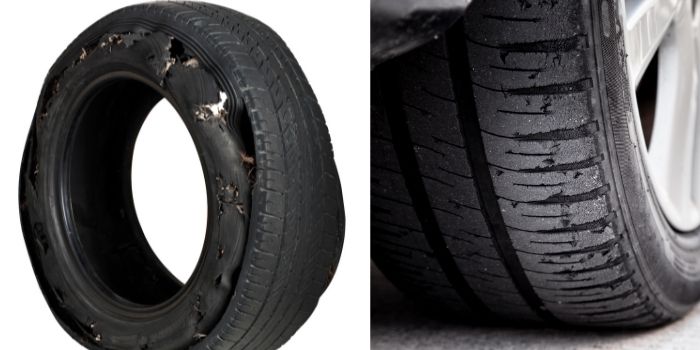If you’re a 6.7L Powerstroke owner, then you know that your truck is packed with power.
But like any other machine, it’s not invincible.
A 6.7L Powerstroke turbo failure can be a costly repair, but it’s important to know the symptoms of a failing turbo so that you can take action before it’s too late.
In this blog post, we’ll outline some of the most common signs of a turbo failure on a 6.7L Powerstroke, and we’ll also provide some tips on how to fix it yourself.
So if you’re experiencing any of these symptoms, don’t panic – read this blog post and see how you can get your turbo up and running again!
Table of Contents
6.7L Powerstroke Turbo Failure Symptoms
The 6.7L Powerstroke Turbo is notorious for failing and unfortunately, there is no one definitive answer as to why this happens.
However, there are a few common symptoms that can help you diagnose the problem.
1- Loud abnormal noise
One of the most common symptoms of a turbo failure is abnormal noise coming from the turbocharger itself.
If you hear any strange noises coming from under the hood, it’s worth investigating further because the loud noises can be a symptom of a faulty turbocharger.
2- Loss of power and poor acceleration
Other symptoms include a loss of power and poor acceleration.
6.7L Powerstroke is known for its speedy engine. However, if it fails your car may not accelerate as quickly or generate as much power as expected when you’re driving.
You could also experience sluggish response and a diminished overall power because of a bad turbocharger.
If you’re experiencing any of these issues, then it’s likely that your turbocharger is failing and needs to be replaced.
3- “Check Engine” Light
Another symptom to watch out for is the “Check Engine” light – that is up on your dashboard.
This can be an indication that there is something wrong with the turbocharger or the engine itself.
Remember, the check engine light doesn’t specify which internal problem your vehicle is exactly facing, so it’s good to go to a mechanic to know why this is happening.
4- Excessive smoke from the exhaust
Excessive black smoke from the exhaust and an increase in engine temperature are other symptoms of a failing turbocharger.
If you notice this, it’s important to take action as soon as possible because it can be an indication that there is damage to the turbine or compressor blades.
5- The Boost Gauge
A boost gauge is a common feature on turbocharged vehicles, which displays the amount of boost being produced.
This is an excellent method to see how well your turbocharger is working.
A reduction in boost indicates that your turbocharger’s performance has been affected.
6- Leaking oil
Last but not least, one of the most common symptoms of a turbocharger failure is leaking oil.
If you see any oil leaks coming from under the hood, it’s likely that your turbocharger is the culprit.
Turbochargers rely on oil for lubrication and if there is a leak, it can cause increased oil consumption along with the turbo to overheat and fail.
How to Fix a 6.7L Powerstroke Turbo Failure?
If you’re experiencing any of the symptoms listed above, the first thing you should do is check your turbocharger for leaks.
If there are no leaks, the next step is to clean the turbocharger. This can be done with a simple can of compressed air.
Once you’ve cleaned the turbocharger, it’s important to check the oil level and quality. If the oil is low or dirty, it could be causing the turbocharger to fail.
Finally, if you’re still experiencing issues, it’s best to consult a professional mechanic who can diagnose the problem and recommend the best course of action.
Should You Replace 6.7l Powerstroke Turbo If There is a Failure?
Replacing 6.7l Powerstroke Turbo can be expensive and it isn’t an easy job.
The cost of replacing the turbocharger on a 6.7L Powerstroke engine may differ depending on the model.
The average cost of replacing a Ford 6.7L Powerstroke turbocharger is between 2300$ and 2900$. Plus, the labor costs are forecasted to be between 360$ and 460$.
So, before you consider replacing your 6.7L Powerstroke turbocharger I recommend taking your vehicle to a qualified mechanic who can notice the symptoms and fix them accordingly.
The mechanic can examine your vehicle and tell you if you need to replace the turbo.
The Conclusion
If you’re experiencing any of the symptoms listed above, then it’s likely that your 6.7L Powerstroke turbocharger is failing and needs to be replaced.
While a 6.7L Powerstroke turbo failure can be a costly repair, it’s important to take action as soon as you notice any of the symptoms.
By doing so, you can avoid further damage and get your truck back on the road as soon as possible.

Based in Orem (Utah) John Paterson graduated from Utah Valley University and has begun writing in 2009. He has a large wealth of experience in writing articles related to cars, automotive repair, wheels, cleaning/maintenance, and much more. He has also written instructional articles in a similar niche for a few online publications as well. Currently, he works as a mechanic in his personal garage shop where he loves serving his countrymen from his heart.





